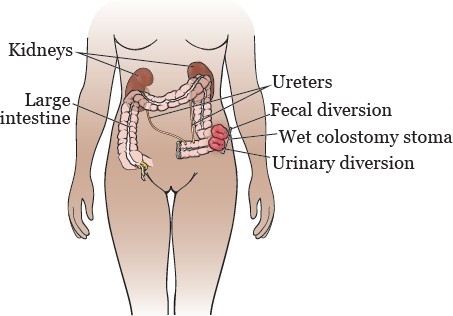A client reports that she ingested 1/2 of a liter of a prep solution for a colonoscopy. How many mL of fluid intake should the practical nurse (PN) document?
(Enter numeric value only. If rounding is required, round to the nearest whole number.)
The Correct Answer is ["500"]
1 liter is equal to 1000 milliliters. Therefore, to calculate the fluid intake in mL, we can multiply 1/2 liter by 1000 mL/liter:
1/2 liter * 1000 mL/liter = 500 mL
So, the practical nurse should document 500 mL as the client's fluid intake.
Nursing Test Bank
Naxlex Comprehensive Predictor Exams
Related Questions
Correct Answer is C
Explanation
The client's question about whether the surgical opening will be visible suggests that they have concerns or misconceptions about the upcoming fecal diversion surgery. By reviewing the client's expectations of elimination after surgery, the PN can provide accurate information and address any anxieties or concerns the client may have.

The other options are not directly related to the client's question and are not the most appropriate actions to take in this situation:
A. Determining if this is the client's first indwelling catheter is unrelated to the client's question about the visibility of the surgical opening. It may be important to assess the client's history of urinary catheter use for other purposes, but it does not address the client's immediate concern.
B. Asking the client if they finished the bowel sterilization prescription is also unrelated to the visibility of the surgical opening. While bowel sterilization may be a part of the preoperative preparation for fecal diversion surgery, it does not address the client's questions and concerns.
D. Verifying that the client had nothing by mouth (NPO) for the past 24 hours is important for general preoperative care but does not address the client's specific question about the visibility of the surgical opening.
Correct Answer is B
Explanation
Antiplatelet medications, such as aspirin or clopidogrel, are prescribed to prevent the formation of blood clots by inhibiting platelet aggregation. These medications can increase the risk of bleeding or prolonged bleeding time. Therefore, when removing the saline lock, applying pressure over the site for several minutes helps to minimize the risk of bleeding and promote hemostasis.
A. Leaving the saline lock in place and notifying the charge nurse may not be necessary unless there are specific concerns or complications related to the client's condition.
C. Encouraging the client to drink additional oral fluids is not directly related to the discontinuation of the saline lock and the potential risk of bleeding associated with antiplatelet medication.
D. Preparing a warm pack to apply after removing the lock is not necessary for this situation. Warm packs are typically used for comfort or to promote circulation, but they are not directly related to the risk of bleeding associated with antiplatelet medication.
Whether you are a student looking to ace your exams or a practicing nurse seeking to enhance your expertise , our nursing education contents will empower you with the confidence and competence to make a difference in the lives of patients and become a respected leader in the healthcare field.
Visit Naxlex, invest in your future and unlock endless possibilities with our unparalleled nursing education contents today
Report Wrong Answer on the Current Question
Do you disagree with the answer? If yes, what is your expected answer? Explain.
Kindly be descriptive with the issue you are facing.
